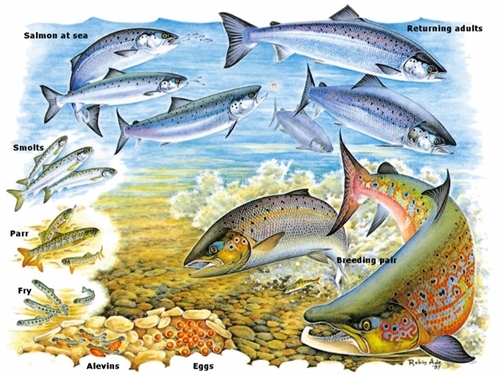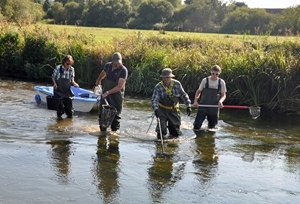Key points
- It was widely reported that numbers of juvenile Atlantic salmon were substantially reduced in rivers around southern Europe, including England and Wales, in 2016.
- Young salmon and trout electro-fishing survey data and egg numbers since 1992 from seven Welsh rivers, representing rivers throughout Wales, were analysed together with river flow and temperature records.
- This study confirmed that there was a crash in the number of young salmon in Wales in 2016 – numbers were the lowest on record for most rivers – and young trout numbers were also low.
- The 2016 crash coincided with increased water temperature over-winter and higher spring water flows across the seven Welsh rivers.
- Although not conclusive, the findings suggest that over-winter temperatures were too high for egg laying and the spring flooding was too much for the few eggs that were spawned and hatched.
- 2019 was one of the hottest winters on record and climate change threatens to bring similar or worse winter conditions for salmon more frequently in the future.
Background
Atlantic salmon have a complicated life cycle that involves several stages, which occur in different habitats. Eggs are laid in freshwater rivers during winter, and over the course of three months or more these develop into very small salmon called alevin, which emerge from the eggs. In the spring, the alevin swim out of the gravel and develop into fry, at which point they begin to eat small, water-living insects. Fry grow larger and become camouflaged to suit their river environment, when they are called parr. These parr live and grow in the river for between one and four years, depending on the river, its temperature and the amount of prey available, until they are ready to ‘smoltify’, when they develop saltwater tolerance at around 13cm in size. Smolts migrate to the ocean, where they go to feed. Finally, they return to their home river after between one and four years to spawn the next generation. They are thought of as an indicator species, one that gives an idea of the overall health of an ecosystem.
 Illustration courtesy of the Atlantic Salmon Trust and Robin Ade.
Illustration courtesy of the Atlantic Salmon Trust and Robin Ade.
Numbers of adult Atlantic salmon and trout in Wales have declined over the last two decades, and elsewhere around the Atlantic Ocean. Numbers of juvenile salmon are generally more variable between years – sometimes increasing, sometimes decreasing – but were noticeably low in 2016. This caused concern for the already vulnerable adult salmon populations because poor recruitment (the name given to the process by which new individuals enter the breeding population, usually by birth) has been suggested as a possible cause of dwindling adult stocks.
This poor recruitment year coincided with extreme winter weather conditions in the rivers around southern Europe, including England and Wales. Given these observations, salmon researchers and managers wondered whether 2016 was a poor year salmon recruitment year or “recruitment crash”, compared to the recent past. And if so, was the recruitment crash linked to the unusually warm overwinter temperatures and high spring flows?
What they did
 Natural Resources Wales (NRW) carried out follow-up electro-fishing survey work (2016-2018) on seven rivers broadly representative of rivers around Wales. They commissioned WRc plc and the GWCT to analyse this data together with survey data from 1992, alongside related fisheries and environmental data, including river flow and temperature records. From this, they examined the extent and possible causes of the 2016 recruitment failure.
Natural Resources Wales (NRW) carried out follow-up electro-fishing survey work (2016-2018) on seven rivers broadly representative of rivers around Wales. They commissioned WRc plc and the GWCT to analyse this data together with survey data from 1992, alongside related fisheries and environmental data, including river flow and temperature records. From this, they examined the extent and possible causes of the 2016 recruitment failure.
The authors developed a statistical model to describe young salmon and trout recruitment from density-dependent and density-independent factors. Density-dependent processes occur when the growth of the population is controlled by the size of the population within a certain area. For example, a larger population might grow slowly because there isn’t enough food to go around. Density-independent factors are those that affect the growth of a population regardless its size. For example, extreme physical or chemical factors such as temperature might cause individuals to die.
The study focused on young (age 0+) salmon and trout that had hatched in spring. This was because they represented a large proportion of the young salmon population in most rivers. Their growth and survival are more strongly influenced by environmental conditions, compared to salmon further along their life cycle.
What they found
The study confirmed that the number of young salmon in 2016 was the lowest on record in the rivers Clwyd, Dee, Teifi, Tywi and Usk, and among the lowest numbers recorded in the rivers Conwy and Wye. For young trout, numbers were low in 2016, but never the lowest in any of the rivers.
Results suggested that salmon recruitment is impacted by both density-dependent and density-independent variables. Numbers of young salmon were highest when egg number was intermediate, i.e. there was neither too many nor two few eggs. It appeared that high temperatures over winter negatively impacted young salmon numbers, perhaps by deterring egg laying, known as spawning. Higher temperatures in spring, however, could favour alevin growth and survival, but they could also be badly affected by floods just prior to or after their emergence. The results for trout were less clear and were driven only by density-independent variables, including high temperatures and flooding before and during egg laying and highwater flow before their emergence from eggs.
What does this mean?
Atlantic salmon recruitment in Welsh rivers is density-dependent and influenced by temperature and flow of water during spawning and emergence. The 2016 crash was likely caused by high water temperatures during egg laying, low water temperatures after they emerged and high flow conditions, including floods, prior to their emergence.
Long-term trends in temperature and flow have shown that extreme weather can impact salmon survival and their resilience will be affected by future climate change scenarios. Both salmon and trout are cold-water species; their eggs are more susceptible to changes in temperature. Continued increases in water temperatures and flood frequency and intensity could affect salmon recruitment and highlight that salmon stock assessment models could be usefully extended to include the influences of environmental conditions in explaining past and predicting future salmon population sizes.
Read the original paper
Gregory, SD, Bewes, VE, Davey, AJH, Roberts, DE, Gough, P, Davidson, IC. (in press). Environmental conditions modify density‐dependent salmonid recruitment: Insights into the 2016 recruitment crash in Wales. Freshwater Biology.